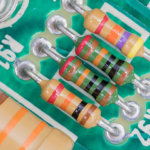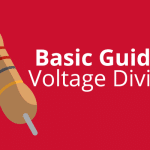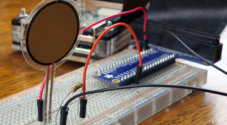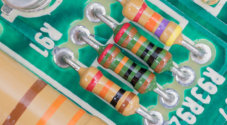An SMD resistor is a type of resistor that has been designed to be surface mounted. These SMD resistors are typically much smaller than traditional resistors, thus taking up much less space on a circuit board.

The SMD part of “SMD Resistor” stands for Surface Mounted Device. An SMD is an electronic component that can be mounted directly to a PCB circuit board by using “Surface Mount Technology” (SMT).
Surface Mount Technology was invented to both reduce the size of components and significantly reduce the time it takes to manufacture a circuit.
SMD resistors are typically something that you will only deal with in professionally manufactured PCB’s.
For most homemade circuits, you will make use of the more classic “through-hole” technology resistors. We have a guide for the color code found on those types of resistor.
The reason for using through hole resistors is that they are much easier to mount and don’t require any specialized equipment as SMD resistors do.
SMD Resistor Calculator
If you want to find out the value of your SMD resistor quickly, you can utilize our calculator.
All you need to do is enter the code that’s on the SMD resistor into the SMD Resistor Code text box below.
The calculator will automatically work out the resistance value of your resistor.
SMD Resistor Code
The first thing you will notice when looking at an SMD resistor is that they do not make use of the color band system that “through-hole” resistors do.
The reason for this is that there isn’t enough room on the smaller SMD resistor packages for the color band code to be printed.
To combat this, they came up with three new code systems, two that are defined under the IEC 60062:2016 standard, a four-digit system, a three-digit system.
The third is a numbering system called “EIA-96” that was specified by the Electronics Industries Alliance who ceased operations back in 2011.
Below we will run through the steps on how to make use of each of these systems.
The Three Digit SMD Resistor Code System
In this system, the first two numbers define the value of the resistor. The third and final digit in this numerical system represents the multiplier for resistance values that are greater than 10 ohms.
When an SMD resistor is under 10 Ohms, the “R” letter is used to define the position of the decimal point. For example, an SMD resistor of 8R3 defines a resistance value of “8.3” Ohms.
Unlike the multiplier for the color code system, the multiplier for this numerical system indicates ten to the power of that number. For example, a resistor of 273 would make the math 27 x 10^3 or in English, twenty-seven times 10 to the power of three.
Examples on How to Work out the Three-Digit SMD Code
For this example, we are going to be assuming that we have four SMD resistors with a three-digit code. One 901, one 3R4, one 313, and one R34.
Example 1 – 901
For the first SMD Resistor 901, we take the first two digits as the resistors base value. Taking the first two digits makes our base resistor value “90“.
We then multiply this base value by 10 to the power of 1 (The final digit in the code).
R = 90 x 10^1
R = 900From this, we can work out that the resistance for our first SMD resistor is 900 Ohms.
Example 2 – 3R4
Now for our second resistor 3R4, we don’t need to deal with any multiplier.
All we need to do is write down the value, placing the decimal point where the R is in the code.
R = 3R4
R = 3.4So from that, we can work out the resistance of the second resistor is 3.4 Ohms.
Example 3 – 313
For the third resistor (313), we need to deal with it just like our first example.
First, grab the first two values so that our base resistance value for our SMD resistor is 31.
From this, we need to grab our final number again as our “power” of 10. We now need to multiply 31 by 10 to the power of 3.
R = 31 x 10 ^ 3
R = 31,000We can work out that the resistor’s actual resistance is 31,000 Ohms or 31K Ohms.
Example 4 – R34
Now for our fourth and final resistor (R34).
This SMD resistor is similar to our second example, but we have moved the decimal place to the front.
R = R34
R = .34Using this, we can quickly work out that the resistance of this SMD resistor is 0.34 Ohms.
The Four Digit SMD Resistor Code System
The four-digit SMD resistor code system is the same as the three-digit system. The only difference being the inclusion of an additional digit.
The first three digits in the four-digit SMD resistor code system signifies the base resistance value. With the fourth and final digit representing the power of the multiplier.
Just like the three-digit system, the multiplier number represents the 10 to the power of number.
Examples on How to Work out the Four Digit SMD Code
To give you more of an idea of how the four-digit SMD resistor code works, we will walk through two different resistors.
The two example resistors that we will be going through is a 4402 and a 95R21 SMD Resistor.
Example 1 – 4402
This first example SMD resistor is our 4402 resistor.
First, we need to take the first three digits from the resistor’s written value, noting that our base resistance value is 440 Ohms.
From this same value, we can get our multiplier of 2 from the last digit of the value of the resistor.
We then need to multiply our base value of 440 by 10 to the power of 2 (Our Multiplier).
R = 440 * 10^2
R = 44,000Calculating this out, we can work out the value of our SMD resistor is 44,000 Ohms.
Example 2 – 95R21
Our second example four digit SMD resistors value is 95R21.
As the value has the “R” letter in it, we immediately know we don’t need to bother with multiplying the value.
All we need to do is replace the “R” with a decimal point to get the actual resistance value of our sample resistor.
R = 95R21
R = 95.21From this, we can work out that our resistors value is 95.21 Ohms.
The EIA-96 System
The third and final system for calculating the resistance values of SMD resistors is the EIA-96 system. It makes use of a three-digit system, with the first two digits representing a value from the E96 series of resistors.
We have a table that shows the corresponding value for each of the 96 possible codes in the E96 series. You can find this table below.
The third digit in the EIA-96 system is always a letter and represents the multiplier. You can make use of our table below to match the letter to its multiplier value.
EIA-96 Multiplier Table
You can utilize this table to quickly work out the multiplier for SMD resistors using the EIA-96 system.
All you need to do is look up the final letter and multiply the value by the multiplier that matches the letter.
| Code | Multiplier |
|---|---|
| Z | 0.001 |
| Y / R | 0.01 |
| X / S | 0.1 |
| A | 1 |
| B / H | 10 |
| C | 100 |
| D | 1,000 |
| E | 10,000 |
| F | 100,000 |
EIA-96 Code Value Table
As the EA-96 numbering system relies on the E96 Series values, you will have to make use of a table like ours to find the actual base resistance value.
Use the table below to look up the first two digits of your EIA-96 SMD resistor to find its base resistance value.
| Code | Value | Code | Value | Code | Value |
|---|---|---|---|---|---|
| 01 | 100 | 33 | 215 | 65 | 464 |
| 02 | 102 | 34 | 221 | 66 | 475 |
| 03 | 105 | 35 | 226 | 67 | 487 |
| 04 | 107 | 36 | 232 | 68 | 499 |
| 05 | 110 | 37 | 237 | 69 | 511 |
| 06 | 113 | 38 | 243 | 70 | 523 |
| 07 | 115 | 39 | 249 | 71 | 536 |
| 08 | 118 | 40 | 255 | 72 | 549 |
| 09 | 121 | 41 | 261 | 73 | 562 |
| 10 | 124 | 42 | 267 | 74 | 576 |
| 11 | 127 | 43 | 274 | 75 | 590 |
| 12 | 130 | 44 | 280 | 76 | 604 |
| 13 | 133 | 45 | 287 | 77 | 619 |
| 14 | 137 | 46 | 294 | 78 | 634 |
| 15 | 140 | 47 | 301 | 79 | 649 |
| 16 | 143 | 48 | 309 | 80 | 665 |
| 17 | 147 | 49 | 316 | 81 | 681 |
| 18 | 150 | 50 | 324 | 82 | 698 |
| 19 | 154 | 51 | 332 | 83 | 715 |
| 20 | 158 | 52 | 340 | 84 | 732 |
| 21 | 162 | 53 | 348 | 85 | 750 |
| 22 | 165 | 54 | 357 | 86 | 768 |
| 23 | 169 | 55 | 365 | 87 | 787 |
| 24 | 174 | 56 | 374 | 88 | 806 |
| 25 | 178 | 57 | 383 | 89 | 825 |
| 26 | 182 | 58 | 392 | 90 | 845 |
| 27 | 187 | 59 | 402 | 91 | 866 |
| 28 | 191 | 60 | 412 | 92 | 887 |
| 29 | 196 | 61 | 422 | 93 | 909 |
| 30 | 200 | 62 | 432 | 94 | 931 |
| 31 | 205 | 63 | 442 | 95 | 953 |
| 32 | 210 | 64 | 453 | 96 | 976 |
Example of working out EIA-96 SMD resistors
Working out the resistance of EIA-96 SMD resistors is a slight bit more complicated than three or four-digit resistors.
The reason for this is that you need to look up what the values of the real digits are as the ones the EIA-96 references are just codes.
To help you understand how to calculate the resistance value of an EIA-96 based SMD resistor, we will run you through three different example resistors.
These example EIA-96 resistor values are 32A, 11Y, 67C.
Example 1 – 32A
The first example resistor that we will be working out is the 32A EIA-96 SMD Resistor.
The first thing we should do is work out the base resistance value. To do this, we must take the first two digits of our resistor.
In this example’s case, the value is 32. looking up this code in our table above, we can work out its resistance value is 210.
Next, we need to work out our multiplier. Again, we do this by looking up the value of A in our multiplier table above. Using the table, we can work out that the multiplier is 1.
Knowing both the base resistance and the multiplier, we can now proceed.
As the multiplier is 1, we know that the resistance of our example 32A EIA-96 SMD Resistor is simply 210.
Example 2 – 11Y
Our second example resistor is slightly more complicated as we use a multiplier that isn’t as simple as multiplying the value by 1.
This second example of SMD resistors value is 11Y.
To start, we need to work out the value our first two digits.
Looking up in our table, we can see that 11 corresponds to the base resistance of 127.
Now that we know the base resistance of our SMD resistor is 127, we can go ahead and work out the multiplier.
Looking up in the multiplier table, we can see that the letter Y means we need to multiply the number by 0.01. This multiplier value is equivalent to dividing the number by 100.
Now that we know the multiplier, we can go ahead and work out the actual resistance of our 11Y resistor by multiplying 127 by 0.01.
R = 127 x 0.01
R = 1.27From the values, we can work out that the value of the 11Y resistor value is 1.27 Ohms.
Example 3 – 67C
Now on to our third example of an EIA-96 SMD resistor, the 67C resistor.
The first thing we should do is take the first two digits of the value on the resistor, which in this example is 67.
Like in our previous two examples, we need to look up 67 in our code table to see its value, which is 487.
Next, we need to work out the multiplier again. Looking up the letter H in our table, we can see that our multiplier is 100.
Using this multiplier by multiplying our base resistance of 487 by our multiplier of 100, we can work out the actual resistance of the SMD resistor.
R = 487 x 100
R = 48,700From these values, we can calculate our final sample SMD resistors resistance as 48,700 Ohms.
Hopefully, at this point, you have now worked out how to read the value of the SMD resistor code and have a basic understanding of these types of resistors.
If you have any tips, feedback, or require assistance, feel free to drop a comment below.










Ingenious and very smart way to calculate SMD. Thumb up. I was lost with all these numbers but not now. Thanks from electronic hobby person.
Great piece of work. very helpful and intuitive